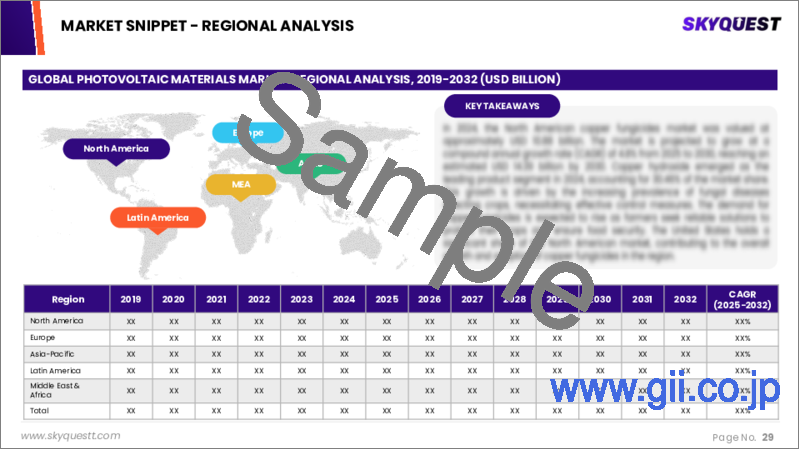|
|
市場調査レポート
商品コード
1643690
太陽電池材料の市場規模、シェア、成長分析:コンポーネント別、製品別、材料別、セルタイプ別、設置タイプ別、用途別、地域別 - 産業予測 2025~2032年Photovoltaic Materials Market Size, Share, Growth Analysis, By Component (Modules, Inverters), By Product (Back Sheets, Encapsulants), By Material, By Cell Type, By Installation Type, By Application, By Region - Industry Forecast 2025-2032 |
||||||
|
|||||||
| 太陽電池材料の市場規模、シェア、成長分析:コンポーネント別、製品別、材料別、セルタイプ別、設置タイプ別、用途別、地域別 - 産業予測 2025~2032年 |
|
出版日: 2025年01月24日
発行: SkyQuest
ページ情報: 英文 238 Pages
納期: 3~5営業日
|
全表示
- 概要
- 目次
太陽電池材料市場規模は2023年に258億米ドルとなり、予測期間(2025-2032年)のCAGRは8.1%で、2024年の278億9,000万米ドルから2032年には520億1,000万米ドルに成長する見通しです。
世界の太陽電池材料市場は、持続可能な電力源としての太陽エネルギー需要の高まりに後押しされ、力強い成長を遂げようとしています。住宅、商業施設、公共施設規模での太陽光発電システムの採用が増加していることが主要な促進要因となっています。シリコン、テルル化カドミウム、セレン化銅インジウムガリウムなどの必須材料は、太陽光から電気への効果的な変換を可能にします。さらに、材料技術の継続的な進歩が、効率と耐久性を高める技術革新につながっています。政府の支援政策とインセンティブが、市場拡大をさらに後押ししています。太陽エネルギーが主流となり、経済的に実行可能なものとなるにつれ、太陽電池材料市場は、再生可能エネルギーソリューションへの大きなシフトを反映して、今後数年間も上昇基調を維持すると予想されます。
目次
イントロダクション
- 調査の目的
- 調査範囲
- 定義
調査手法
- 情報調達
- 二次データと一次データの方法
- 市場規模予測
- 市場の前提条件と制限
エグゼクティブサマリー
- 世界市場の見通し
- 供給と需要の動向分析
- セグメント別機会分析
市場力学と見通し
- 市場概要
- 市場規模
- 市場力学
- 促進要因と機会
- 抑制要因と課題
- ポーターの分析
主な市場の考察
- 重要成功要因
- 競合の程度
- 主な投資機会
- 市場エコシステム
- 市場の魅力指数(2024年)
- PESTEL分析
- マクロ経済指標
- バリューチェーン分析
- 価格分析
- 規制情勢
- ケーススタディ
- 技術分析
- 貿易分析
- 原材料の分析
- 特許分析
太陽電池材料市場規模:コンポーネント別& CAGR(2025-2032)
- 市場概要
- モジュール
- インバーター
- システムバランス(BOS)
- 接続とケーブル
- ジャンクションボックス
- 安全装備
- トラッカー
- バッテリー
- 監視システム
- その他
太陽電池材料市場規模:製品別& CAGR(2025-2032)
- 市場概要
- 裏表紙
- カプセル化剤
- 表紙
- その他
太陽電池材料市場規模:材料別& CAGR(2025-2032)
- 市場概要
- シリコン
- 結晶シリコン(C-Si)
- 薄膜
- 化合物
- 銅インジウムガリウムセレン化物(CIGS)
- テルル化カドミウム(CDTE)
太陽電池材料市場規模:セルタイプ別& CAGR(2025-2032)
- 市場概要
- フルセルPVモジュール
- ハーフセルPVモジュール
太陽電池材料市場規模:設置タイプ別& CAGR(2025-2032)
- 市場概要
- 地上設置型
- 建物一体型太陽光発電(BIPV)
- 屋上
- 窓
- 水上太陽光発電
太陽電池材料市場規模:用途別& CAGR(2025-2032)
- 市場概要
- 住宅用
- 商業・産業用
- ユーティリティ
太陽電池材料市場規模:地域別& CAGR(2025-2032)
- 北米
- 米国
- カナダ
- 欧州
- ドイツ
- スペイン
- フランス
- 英国
- イタリア
- その他欧州地域
- アジア太平洋地域
- 中国
- インド
- 日本
- 韓国
- その他アジア太平洋地域
- ラテンアメリカ
- ブラジル
- その他ラテンアメリカ地域
- 中東・アフリカ
- GCC諸国
- 南アフリカ
- その他中東・アフリカ
競合情報
- 上位5社の比較
- 主要企業の市場ポジショニング(2024年)
- 主な市場企業が採用した戦略
- 市場の最近の動向
- 企業の市場シェア分析(2024年)
- 主要企業の企業プロファイル
- 会社概要
- 製品ポートフォリオ分析
- セグメント別シェア分析
- 収益の前年比比較(2022-2024)
主要企業プロファイル
- LONGi Green Energy Technology Co., Ltd.(China)
- JinkoSolar Holding Co., Ltd.(China)
- Trina Solar Limited(China)
- JA Solar Technology Co., Ltd.(China)
- Chint Group Corporation(China)
- Tongwei Co., Ltd.(China)
- Canadian Solar Inc.(Canada)
- Risen Energy Co., Ltd.(China)
- DAS Solar Co., Ltd.(China)
- GCL-Poly Energy Holdings Limited(China)
- First Solar, Inc.(USA)
- SunPower Corporation(USA)
- Wacker Chemie AG(Germany)
- DuPont de Nemours, Inc.(USA)
- Honeywell International Inc.(USA)
- Mitsubishi Materials Corporation(Japan)
- Targray Technology International Inc.(Canada)
- Ferrotec Holdings Corporation(Japan)
- COVEME S.p.A.(Italy)
- Hangzhou First Applied Material Co., Ltd.(China)
結論と推奨事項
Photovoltaic Materials Market size was valued at USD 25.8 billion in 2023 and is poised to grow from USD 27.89 billion in 2024 to USD 52.01 billion by 2032, growing at a CAGR of 8.1% during the forecast period (2025-2032).
The global photovoltaic materials market is poised for robust growth, fueled by rising demand for solar energy as a sustainable power source. The increasing adoption of photovoltaic systems across residential, commercial, and utility-scale sectors is a key driver. Essential materials, including silicon, cadmium telluride, and copper indium gallium selenide, enable effective sunlight-to-electricity conversion. Additionally, ongoing advancements in materials technology are leading to innovations that enhance efficiency and durability. Supportive government policies and incentives further bolster market expansion. As solar energy becomes more mainstream and economically viable, the photovoltaic materials market is anticipated to maintain its upward trajectory in the coming years, reflecting a significant shift towards renewable energy solutions.
Top-down and bottom-up approaches were used to estimate and validate the size of the Photovoltaic Materials market and to estimate the size of various other dependent submarkets. The research methodology used to estimate the market size includes the following details: The key players in the market were identified through secondary research, and their market shares in the respective regions were determined through primary and secondary research. This entire procedure includes the study of the annual and financial reports of the top market players and extensive interviews for key insights from industry leaders such as CEOs, VPs, directors, and marketing executives. All percentage shares split, and breakdowns were determined using secondary sources and verified through Primary sources. All possible parameters that affect the markets covered in this research study have been accounted for, viewed in extensive detail, verified through primary research, and analyzed to get the final quantitative and qualitative data.
Photovoltaic Materials Market Segments Analysis
Global Photovoltaic Materials Market is segmented by Component, Product, Material, Cell Type, Installation Type, Application and region. Based on Component, the market is segmented into Modules, Inverters and Balance of System (BOS). Based on Product, the market is segmented into Back Sheets, Encapsulants, Front Sheets and Others. Based on Material, the market is segmented into Silicon and Compounds. Based on Cell Type, the market is segmented into Full-Cell PV Modules and Half-Cell PV Modules. Based on Installation Type, the market is segmented into Ground-mounted, Building-Integrated Photovoltaics (BIPV) and Floating PV. Based on Application, the market is segmented into Residential, Commercial & Industrial and Utilities. Based on region, the market is segmented into North America, Europe, Asia Pacific, Latin America and Middle East & Africa.
Driver of the Photovoltaic Materials Market
A key driver propelling the global photovoltaic materials market is the rising adoption of renewable energy sources, especially solar power, in response to the escalating global energy requirements. With an emphasis on minimizing carbon emissions and advocating for clean energy solutions, governments and organizations around the world are actively promoting the deployment of solar photovoltaic (PV) systems. This increasing focus on sustainability has resulted in a considerable surge in the demand for various photovoltaic materials, including solar cells, modules, and other related components, further reinforcing the industry's growth and aligning with global efforts towards a greener energy future.
Restraints in the Photovoltaic Materials Market
One notable restraint affecting the global photovoltaic materials market is the high cost associated with photovoltaic (PV) technologies. Despite significant reductions in solar panel and PV system prices over recent years, the initial investment necessary for installing solar power systems remains comparatively steep. This financial barrier can be particularly challenging in areas with constrained financial resources or where alternative energy options are more economically viable. Furthermore, the variability in raw material prices, such as silicon, poses additional challenges by influencing the profitability and overall cost-effectiveness of PV projects, thereby hindering market growth and adoption.
Market Trends of the Photovoltaic Materials Market
The global photovoltaic materials market is witnessing a robust trend towards the adoption of advanced and next-generation materials, spurred by the increasing demand for enhanced solar energy solutions. As the solar energy sector expands, there is a notable pivot from traditional silicon-based materials to innovative alternatives such as perovskites, organic photovoltaics, and thin-film technologies. These materials promise superior energy conversion efficiencies, greater flexibility, and reduced weight, catering to diverse applications. This shift aims to bolster solar cell performance while driving down production costs, ultimately making solar energy more accessible and efficient. The emphasis on sustainable and high-performing materials marks a significant evolution in the photovoltaic landscape, setting the stage for a more integrated future in renewable energy.
Table of Contents
Introduction
- Objectives of the Study
- Scope of the Report
- Definitions
Research Methodology
- Information Procurement
- Secondary & Primary Data Methods
- Market Size Estimation
- Market Assumptions & Limitations
Executive Summary
- Global Market Outlook
- Supply & Demand Trend Analysis
- Segmental Opportunity Analysis
Market Dynamics & Outlook
- Market Overview
- Market Size
- Market Dynamics
- Drivers & Opportunities
- Restraints & Challenges
- Porters Analysis
- Competitive rivalry
- Threat of substitute
- Bargaining power of buyers
- Threat of new entrants
- Bargaining power of suppliers
Key Market Insights
- Key Success Factors
- Degree of Competition
- Top Investment Pockets
- Market Ecosystem
- Market Attractiveness Index, 2024
- PESTEL Analysis
- Macro-Economic Indicators
- Value Chain Analysis
- Pricing Analysis
- Regulatory Landscape
- Case Studies
- Technology Analysis
- Trade Analysis
- Raw Material Analysis
- Patent Analysis
Global Photovoltaic Materials Market Size by Component & CAGR (2025-2032)
- Market Overview
- Modules
- Inverters
- Balance of System (BOS)
- Connections & Cables
- Junction Boxes
- Safety Equipment
- Trackers
- Batteries
- Monitoring Systems
- Others
Global Photovoltaic Materials Market Size by Product & CAGR (2025-2032)
- Market Overview
- Back Sheets
- Encapsulants
- Front Sheets
- Others
Global Photovoltaic Materials Market Size by Material & CAGR (2025-2032)
- Market Overview
- Silicon
- Crystalline Silicon (C-Si)
- Thin Film
- Compounds
- Copper Indium Gallium Selenide (CIGS)
- Cadmium Telluride (CDTE)
Global Photovoltaic Materials Market Size by Cell Type & CAGR (2025-2032)
- Market Overview
- Full-Cell PV Modules
- Half-Cell PV Modules
Global Photovoltaic Materials Market Size by Installation Type & CAGR (2025-2032)
- Market Overview
- Ground-mounted
- Building-Integrated Photovoltaics (BIPV)
- Rooftops
- Windows
- Floating PV
Global Photovoltaic Materials Market Size by Application & CAGR (2025-2032)
- Market Overview
- Residential
- Commercial & Industrial
- Utilities
Global Photovoltaic Materials Market Size & CAGR (2025-2032)
- North America (Component, Product, Material, Cell Type, Installation Type, Application)
- US
- Canada
- Europe (Component, Product, Material, Cell Type, Installation Type, Application)
- Germany
- Spain
- France
- UK
- Italy
- Rest of Europe
- Asia Pacific (Component, Product, Material, Cell Type, Installation Type, Application)
- China
- India
- Japan
- South Korea
- Rest of Asia-Pacific
- Latin America (Component, Product, Material, Cell Type, Installation Type, Application)
- Brazil
- Rest of Latin America
- Middle East & Africa (Component, Product, Material, Cell Type, Installation Type, Application)
- GCC Countries
- South Africa
- Rest of Middle East & Africa
Competitive Intelligence
- Top 5 Player Comparison
- Market Positioning of Key Players, 2024
- Strategies Adopted by Key Market Players
- Recent Developments in the Market
- Company Market Share Analysis, 2024
- Company Profiles of All Key Players
- Company Details
- Product Portfolio Analysis
- Company's Segmental Share Analysis
- Revenue Y-O-Y Comparison (2022-2024)
Key Company Profiles
- LONGi Green Energy Technology Co., Ltd. (China)
- Company Overview
- Business Segment Overview
- Financial Updates
- Key Developments
- JinkoSolar Holding Co., Ltd. (China)
- Company Overview
- Business Segment Overview
- Financial Updates
- Key Developments
- Trina Solar Limited (China)
- Company Overview
- Business Segment Overview
- Financial Updates
- Key Developments
- JA Solar Technology Co., Ltd. (China)
- Company Overview
- Business Segment Overview
- Financial Updates
- Key Developments
- Chint Group Corporation (China)
- Company Overview
- Business Segment Overview
- Financial Updates
- Key Developments
- Tongwei Co., Ltd. (China)
- Company Overview
- Business Segment Overview
- Financial Updates
- Key Developments
- Canadian Solar Inc. (Canada)
- Company Overview
- Business Segment Overview
- Financial Updates
- Key Developments
- Risen Energy Co., Ltd. (China)
- Company Overview
- Business Segment Overview
- Financial Updates
- Key Developments
- DAS Solar Co., Ltd. (China)
- Company Overview
- Business Segment Overview
- Financial Updates
- Key Developments
- GCL-Poly Energy Holdings Limited (China)
- Company Overview
- Business Segment Overview
- Financial Updates
- Key Developments
- First Solar, Inc. (USA)
- Company Overview
- Business Segment Overview
- Financial Updates
- Key Developments
- SunPower Corporation (USA)
- Company Overview
- Business Segment Overview
- Financial Updates
- Key Developments
- Wacker Chemie AG (Germany)
- Company Overview
- Business Segment Overview
- Financial Updates
- Key Developments
- DuPont de Nemours, Inc. (USA)
- Company Overview
- Business Segment Overview
- Financial Updates
- Key Developments
- Honeywell International Inc. (USA)
- Company Overview
- Business Segment Overview
- Financial Updates
- Key Developments
- Mitsubishi Materials Corporation (Japan)
- Company Overview
- Business Segment Overview
- Financial Updates
- Key Developments
- Targray Technology International Inc. (Canada)
- Company Overview
- Business Segment Overview
- Financial Updates
- Key Developments
- Ferrotec Holdings Corporation (Japan)
- Company Overview
- Business Segment Overview
- Financial Updates
- Key Developments
- COVEME S.p.A. (Italy)
- Company Overview
- Business Segment Overview
- Financial Updates
- Key Developments
- Hangzhou First Applied Material Co., Ltd. (China)
- Company Overview
- Business Segment Overview
- Financial Updates
- Key Developments





